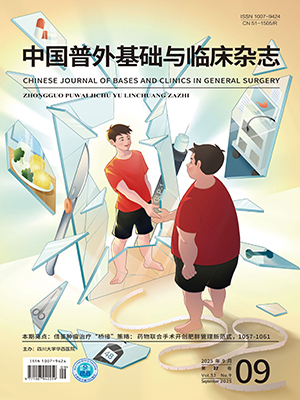| 1. |
黄理宾, 黄秋实, 杨烈. 全球及中国的结直肠癌流行病学特征及防治: 2022《全球癌症统计报告》解读. 中国普外基础与临床杂志, 2024, 31(5): 530-537.
|
| 2. |
Liu B, Hu Y, Rai SK, et al. Low-carbohydrate diet macronutrient quality and weight change. JAMA Netw Open, 2023, 6(12): e2349552. doi: 10.1001/jamanetworkopen.2023.49552.
|
| 3. |
Fuchs MA, Sato K, Niedzwiecki D, et al. Sugar-sweetened beverage intake and cancer recurrence and survival in CALGB 89803 (Alliance). PLoS One, 2014, 9(6): e99816. doi: 10.1371/journal.pone.0099816.
|
| 4. |
Grasgruber P, Hrazdira E, Sebera M, et al. Cancer incidence in Europe: an ecological analysis of nutritional and other environmental factors. Front Oncol, 2018, 8: 151. doi: 10.3389/fonc.2018.00151.
|
| 5. |
Goncalves MD, Lu C, Tutnauer J, et al. High-fructose corn syrup enhances intestinal tumor growth in mice. Science, 2019, 363(6433): 1345-1349.
|
| 6. |
Liu X, Xie C, Wang Y, et al. Ferritinophagy and ferroptosis in cerebral ischemia reperfusion injury. Neurochem Res, 2024, 49(8): 1965-1979.
|
| 7. |
Shi X, Zhang A, Lu J, et al. An overview of heavy chain ferritin in cancer. Front Biosci (Landmark Ed), 2023, 28(8): 182. doi: 10.31083/j.fbl2808182.
|
| 8. |
Li S, Huang P, Lai F, et al. Mechanisms of ferritinophagy and ferroptosis in diseases. Mol Neurobiol, 2024, 61(3): 1605-1626.
|
| 9. |
张小利. 高脂饮食促进结肠炎相关结肠癌发生发展的机制初探. 北京: 中国医学科学院北京协和医学院, 2020.
|
| 10. |
李国强, 李彦川, 冯任南, 等. 基于网络的食物频率问卷信度和效度研究. 哈尔滨医科大学学报, 2014, 48(5): 376-380.
|
| 11. |
祁少俊, 唐延金, 张正铎, 等. 补充多种微量元素对高糖饮食大鼠的保护作用. 山东大学学报(医学版), 2023, 61(7): 19-26.
|
| 12. |
Singh LP, Yumnamcha T, Devi TS. Mitophagy, ferritinophagy and ferroptosis in retinal pigment epithelial cells under high glucose conditions: implications for diabetic retinopathy and age-related retinal diseases. JOJ Ophthalmol, 2021, 8(5): 77-85.
|
| 13. |
Kim J, Kim Y, La J, et al. Supplementation with a high-glucose drink stimulates anti-tumor immune responses to glioblastoma via gut microbiota modulation. Cell Rep, 2023, 42(10): 113220. doi: 10.1016/j.celrep.2023.113220.
|
| 14. |
Wang M, Liu J, Yan L, et al. Burden of liver cancer attributable to high fasting plasma glucose: a global analysis based on the global burden of disease study 2019. J Nutr Health Aging, 2024, 28(6): 100261. doi: 10.1016/j.jnha.2024.100261.
|
| 15. |
Miles FL, Neuhouser ML, Zhang ZF. Concentrated sugars and incidence of prostate cancer in a prospective cohort. Br J Nutr, 2018, 120(6): 703-710.
|
| 16. |
Dewdney B, Roberts A, Qiao L, et al. A sweet connection? Fructose’s role in hepatocellular carcinoma. Biomolecules, 2020, 10(4): 496. doi: 10.3390/biom10040496.
|
| 17. |
Bellelli R, Federico G, Matte’ A, et al. NCOA4 deficiency impairs systemic iron homeostasis. Cell Rep, 2016, 14(3): 411-421.
|
| 18. |
Wang R, Liang Z, Xue X, et al. Microglial FoxO3a deficiency ameliorates ferroptosis-induced brain injury of intracerebral haemorrhage via regulating autophagy and heme oxygenase-1. J Cell Mol Med, 2024, 28(1): e18007. doi: 10.1111/jcmm.18007.
|
| 19. |
Liu YC, Gong YT, Sun QY, et al. Ferritinophagy induced ferroptosis in the management of cancer. Cell Oncol (Dordr), 2024, 47(1): 19-35.
|
| 20. |
储昭银, 苏青. 碳水化合物与恶性肿瘤发生风险. 上海医学, 2021, 44(4): 286-292.
|
| 21. |
Twarda-Clapa A, Olczak A, Białkowska AM, et al. Advanced glycation end-products (AGEs): formation, chemistry, classification, receptors, and diseases related to AGEs. Cells, 2022, 11(8): 1312. doi: 10.3390/cells11081312.
|
| 22. |
Yamamoto T, Shiburo R, Moriyama Y, et al. Protein components of maple syrup as a potential resource for the development of novel anti-colorectal cancer drugs. Oncol Rep, 2023, 50(4): 179. doi: 10.3892/or.2023.8616.
|
| 23. |
Pan S, Hu B, Sun J, et al. Identification of cross-talk pathways and ferroptosis-related genes in periodontitis and type 2 diabetes mellitus by bioinformatics analysis and experimental validation. Front Immunol, 2022, 13: 1015491. doi: 10.3389/fimmu.2022.1015491.
|
| 24. |
Song X, Zheng Y, Liu Y, et al. Production of recombinant human hybrid ferritin with heavy chain and light chain in escherichia coli and its characterization. Curr Pharm Biotechnol, 2023, 24(2): 341-349.
|
| 25. |
He J, Li Z, Xia P, et al. Ferroptosis and ferritinophagy in diabetes complications. Mol Metab, 2022, 60: 101470. doi: 10.1016/j.molmet.2022.101470.
|
| 26. |
Bao L, Zhao C, Feng L, et al. Ferritinophagy is involved in Bisphenol A-induced ferroptosis of renal tubular epithelial cells through the activation of the AMPK-mTOR-ULK1 pathway. Food Chem Toxicol, 2022, 163: 112909. doi: 10.1016/j.fct.2022.112909.
|
| 27. |
姚阳. 高糖通过激活AMPK/mTOR/ULK1通路诱导成骨细胞铁自噬进而促进铁死亡在2型糖尿病骨质疏松中的机制研究. 中国医科大学, 2022.
|
| 28. |
Qin X, Zhang J, Wang B, et al. Ferritinophagy is involved in the zinc oxide nanoparticles-induced ferroptosis of vascular endothelial cells. Autophagy, 2021, 17(12): 4266-4285.
|




